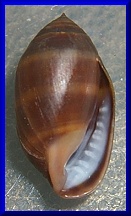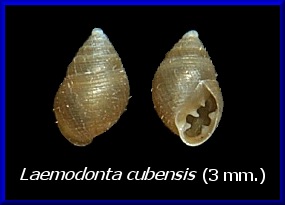| A Florida Marsh Snail Hunt | |
| By Phil Poland | |
|
|
Ellobium dominicense - with humus under rotting leaves, John Pennekamp Coral Reef State Park, Key Largo, Monroe Co., Florida. (18 mm.). Collected by the author |
| A recent
monograph (A.M.F. Martins, Malacologia*) on the Ellobiidae
(formerly Melampidae), or marsh snails, got me going on a enjoyable
project. Martins' work is comprehensive, with detailed habitat
and range information. The plates are great. A happy fact about
marsh snails is that they can be sought and found when tide, weather
or season isn't ideal for most collecting. These air breathing
snails generally live in protected areas near or above high-water.
As most of the Western Atlantic species have been found in south
Florida, I planned to make a determined search on my next Keys
trip. I left Clearwater for the Keys in late September, taking
the interstate south. My first stop was at the Myakka River at
US 41, a short jog off the interstate near Port Charlotte. I'd
been surprised to learn from Martins that Melampus floridanus
had been found there. I'd thought it was a species from northeast
Florida and northward. What I found was a freshwater river bank. Vitta usnea were abundant at the water's edge, but no sign of Melampus on the grasses further up the bank. It took a few minutes to figure out that the fragile, banded, 5 mm. snail lived under rotting plant debris at the wrack line. Though abundant, it took a close look to find. It is the only Florida marsh snail found in this freshwater environment. With the data and snails bagged and in the cooler, I headed to Miami via Alligator Alley. My destination was Key Biscayne, near the northeast end of the island chain we call the Keys. I don't accept the idea that the Keys begin with the billboards at the Monroe County line. At the north end of Key Biscayne, a rocky shore and a mangrove swamp looked promising for the marsh snails. Sadly, for the purposes of this story, netting of marine grasses and other subtidal collecting activities at this location were very productive, and I was distracted for a few precious hours. One of Florida's least common ellobiids, Tralia ovula, was found on the shore as a dead shell. A belated search under rocks and debris near high-water turned up no live specimens. I plan a return trip to try again and to "do the swamp" that time didn't allow on this visit. The following day found me, bright and early, at Harry Harris County Park near Tavernier in the Upper Keys. A hard shore with tidepools gave way to mangrove and a gently sloping shore. The mangrove sheltered a bonanza in marsh snails. After clearing a path through the spider webs, I was able to find a reasonably comfortable spot near the high-water mark to turn rocks and debris around the roots of the mangrove. Melampus coffea were the first spotted, actively moving about on mangrove roots and most other wet surfaces in this well-shaded area. Melampus bidentatus were fairly common here too, though closer to the ground. Their shells are generally lighter in color and more slender than those of the larger M. coffea. Striae on the shoulders are the verifying feature (M. coffea have none).
Melampus monilis clustered in crevices on the undersurfaces of rocks and larger pieces of wood. The deep-brown shells, sometimes banded, have tiny hairs or setae on the tops of the whorls. Pits remain if they've worn off. Melampus bullaoides, distinctively tapering at both ends, were easily found under rocks and debris near the high-water mark. At a location on Florida Bay near the Marathon Airport, I found that rocks, just above the high-water mark and shaded by mangrove, hid populations of three other marsh snail species.
Some of the rocks from near the high-water mark were rinsed in a bucket of saltwater. The collected "gravel" contained tiny and fragile Microtralia ovulum. These 3 mm. translucent snails were not discovered until the frozen material was thawed and examined at home. Other species under the rocks included Assiminea and three Truncatella species. At Middle Torch Key, on the salt barrens, shaded and damp areas with an accumulation of organic matter harbor a rarely collected species, Ellobium dominicense (formerly E. pellucens). Their presence is indicated, wherever they are found, by numbers of dead shells accumulated near wrack lines. Colonies apparently bloom and die off regularly. I was able to find live snails by moving large rocks and wood debris. At Sugarloaf Key, near the famous (sort of) bat tower at Perky, low and open ground, periodically flooded by the highest of tides, is a great spot to find Melampus morrisoni. Wherever wood debris occurred, fine specimens of M. morrisoni did too. Banded or solid, brown or white, the cylindrical and distinctively dentate adult shell isn't too difficult to separate from other marsh snails that occur with it. In dense mangrove nearby, rotting plant matter accumulates among the roots to a considerable depth. Coconuts and other wood embedded in this material were rinsed in a bucket of seawater and two other species collected. Blauneria heteroclita, a white pellucid snail in a sinistral and transparent 3 mm. shell, stood out vividly against the black of rotting wood. A little less conspicuous, and found with Blauneria, was Creedonia succinea (formerly Marinula succinea). Also a 3 mm. shell, it was easily collected by rinsing wood and examining what settled in the bottom of the bucket. Indications are that at least two other marsh snails live in Florida, one in the Keys, one in the northeast. The hunt continues. During this little field trip of a few days, I collected snails under tree bark, in dirt, from marine algae and grass, under rocks and in sand. Hundreds of little species, some not even named, are there to challenge you when you've gotten all the cones and cowries. Good Luck! *Malacologia 37(2): 163-356, Academy of Natural Sciences of Philadelphia, 1996. |
|

 Young Melampus morrisoni (formerly Detracia clarki)
were found with M. bidentatus but were not recognized
as such until brought home and cleaned. While the young superficially
resemble M. bidentatus, the upturned columellar teeth
give this species away.
Young Melampus morrisoni (formerly Detracia clarki)
were found with M. bidentatus but were not recognized
as such until brought home and cleaned. While the young superficially
resemble M. bidentatus, the upturned columellar teeth
give this species away. Laemodonta
cubensis, a 3 mm. species with a hispid periostracum, was
found in several dense colonies. Pedipes ovalis, which
has generally been lumped with P. mirabilis, was abundant
at this location, and is common throughout the Keys. Pedipes
ovalis can be distinguished from P. mirabilis by
its protoconch, dentition and finer sculpture. I have found P.
mirabilis on the east coast of Florida, P. ovalis
only in the Keys and on the west coast.
Laemodonta
cubensis, a 3 mm. species with a hispid periostracum, was
found in several dense colonies. Pedipes ovalis, which
has generally been lumped with P. mirabilis, was abundant
at this location, and is common throughout the Keys. Pedipes
ovalis can be distinguished from P. mirabilis by
its protoconch, dentition and finer sculpture. I have found P.
mirabilis on the east coast of Florida, P. ovalis
only in the Keys and on the west coast.